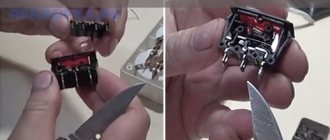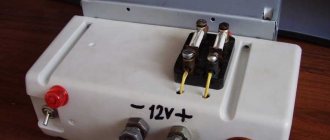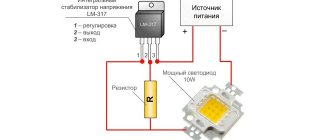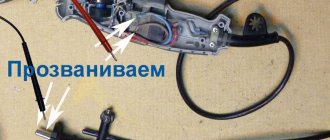There are a large number of circuits used in electronics and electrical engineering that require the isolation or separation of high power voltages from low voltage control circuits. This creates a kind of protection for low-voltage devices from the influence of high voltage. That is, in such circuits there is no longer the flow of ordinary electric current. In such cases, in the absence of current, a large ohmic resistance arises between the devices, causing an open circuit. This problem is successfully solved by galvanic isolation, which removes the galvanic connection between devices.
Operating principle
Galvanic isolation, according to its function, is also known as galvanic isolation. These systems provide electrical isolation of a specific circuit from other types of circuits nearby. The use of galvanic isolation allows for contactless control and provides reliable protection of people and equipment from electric shock.
Due to its features, galvanic isolation ensures the exchange of signals or energy between circuits, while eliminating direct electrical contact. With its help, an independent signal circuit is formed by forming an independent current circuit of the signal circuit in relation to the current circuits of other circuits.
Galvanic isolation is used during measurements in power and feedback circuits. This technical solution also ensures electromagnetic compatibility, enhances protection against interference, and improves measurement accuracy. The galvanic isolation unit used at the input and output of each device improves their compatibility with other devices in difficult electromagnetic environments.
In order to better understand what galvanic isolation is, we can consider its action using the example of a standard industrial electric motor. In most cases, production uses a supply voltage that significantly exceeds 220 volts and poses a serious danger to operating personnel.
Connection procedure
Single-phase voltage is generated by connecting one of the phases to the neutral wire through the load. In our case, the primary winding serves as the load. Therefore, when phase current enters the body of the device, then when it touches and simultaneously contacts a grounded object, an electric current passes through the operator’s body.
The use of the galvanic isolation method eliminates this possibility, since the secondary winding is not grounded. Therefore, before connecting, make sure that you are really dealing with an isolation transformer. To do this, use a tester to check that the secondary winding is not connected to the housing and to the turns of the primary winding.
In the event that there is only one secondary winding, and both coils are physically separated into different parts of the core, a visual inspection can be done. Otherwise, verification is required. Note that galvanic coupling may exist between the secondary windings (if there are several of them), and this is normal.
An example of a connection diagram is shown in Figure 5. Please note that the housing of the equipment connected to the primary circuit in this diagram is grounded. In addition, in order to enhance protection, an RCD was applied. If you are using a portable or stationary isolation transformer, there is no need to ground the equipment in the secondary circuit.
Rice. 5. Connection diagram
The potential difference between phase and ground in the primary circuit is 220 V, while in the protected circuit the voltage between phase and ground is zero.
Connect loads whose power does not exceed the transformer rating. Failure to comply with this rule can lead to overheating of the windings, which can lead to insulation damage.
Transformer (inductive) isolation
In order to build inductive isolation, you should use magnetic induction devices - transformers. Its design can be cored or coreless.
Equipping circuits with galvanic isolation of the inductive type is carried out using transformers whose transformation ratio is unity. The primary coil is connected to the signal source, and the secondary coil is connected to the receiver. On this principle, transformer-type galvanic isolations serve as the basis for the creation of magnetic modulation devices.
The output voltage arising in the secondary winding is directly related to the voltage at the input of the transformer device. In this regard, inductive isolation has serious disadvantages, which is why its use is limited:
- It is impossible to manufacture a compact device due to the significant overall dimensions of the transformer.
- The transmission frequency is limited by the frequency modulation of the isolation itself.
- Noise occurring in the input signal reduces the quality of the output signal.
- Such transformer galvanic isolation can only operate normally in the presence of alternating voltage.
Methods for decoupling an analog signal
A short review. There are three main methods of galvanic isolation of an analog signal: transformer, optical and capacitor. The first two have found the greatest application. Today there is a whole class of devices called isolating amplifiers or isolating amplifiers (Isolated Amplifier). Such devices transmit a signal by means of its conversion (the circuit contains a modulator and a signal demodulator).
Fig.1. General circuit of isolating amplifiers.
There are devices both for transmitting an analog voltage signal (ADUM3190, ACPL-C87) and specialized ones for connecting directly to a current shunt (SI8920, ACPL-C79, AMC1200). In this article we will not consider expensive devices, but we will list some of them: iso100, iso124, ad202..ad215, etc.
There is also another class of devices - decoupling optical amplifiers with linearizing feedback (Linear Optocoupler); these devices include il300, loc110, hcnr201. The operating principle of these devices is easy to understand by looking at their typical connection diagram.
Fig.2. Typical circuit for isolating optical amplifiers.
You can read more about isolation amplifiers: A. J. Peyton, W. Walsh “Analog Electronics on Op-amps” (Chapter 2), the document AN614 “A Simple Alternative To Analog Isolation Amplifiers” from silicon labs will also be useful, there is a good one there comparison table. Both sources are available on the Internet.
Operating principle of capacitive decoupling
The question often arises as to why different types of decoupling are needed, including capacitive decoupling. This circuit represents a system in which there are no connections between the circuits through current, ground and other elements.
In this case, the transmission of data from electrical circuits is carried out using an alternating electric field. The insulation of the circuits occurs due to the dielectric located between the capacitor plates. The quality of the decoupling capacitor is determined by the properties of the dielectric, the size of the plates and the distance between them. This type of insulation has increased energy efficiency; devices based on it are small in size, capable of transmitting electricity and do not respond to external electromagnetic fields.
Normal operation of devices is ensured by separation of signal and interference frequencies. Thus, the capacitance provides very little resistance to the working signal, but creates a barrier for interference.
Galvanic isolation and power-off delay module for DIY audio processor in car
Good afternoon everyone. This will be a short review note. The year is ending, and I still have one unfinished question as part of the reviews. If anyone has been following, in my review of a DIY audio processor in a car, after installing the device, I was left with the problem of interference along the power line (you could hear the pleasant hum of the generator in the speakers at low volume), as well as the problem of a slight pop in the speakers after turning off the power. Similar problems also appeared among people who decided to repeat my project, and, accordingly, questions arose about eliminating these shortcomings of the system. During the search for solution options, a small galvanic power isolation module (based on the B1212S-2W DC-DC converter) and a delay circuit for turning off the audio processor power were born. The result was a working prototype, which has already been successfully tested. Details in the review. I had already encountered the problem of interference and noise along the power line of the processor on the ADAU1701 earlier, when introducing an audio processor into a home ULF. There I tried different power supply options, but I still had to catch the earth loop. That was until I decided to try to power the DSP board from the DC-DC converter that was installed on the PiFi I2C DAC for the RaspberryPi. It was a DC-DC module with galvanic isolation B0505S. I soldered it to the converter pins on the board and all the noise and interference disappeared. I decided to apply the same method to the audio processor in the car. For my device, I decided to purchase the B1212S-2W module. I ordered from three places:
- 1 piece/lot B1212S B1212S-2W DIP-4
- 1 piece/lot B1212S-2W B1212S B1212S-2 B1212 DIP-4
- 1 PC. B1212S-2W DIP-4 Module Authentic B1212S B1212S-2 DIP B1212
All workers.
The converter looks like this:
Using recommendations for connecting these modules from one of the manufacturers (DELUS B-1W & F-1W Series)
I assembled a small circuit on a breadboard from a 1A fuse, a diode, a capacitor (I placed two in parallel at 820 uF) and a B1212S-2W module. After the converter I installed a 1.8 uF film capacitor:
I assembled it and went to try it in the car. The power supply noise disappeared, there was immediate silence, but the popping sound only increased when turned off, and it became really audible, which is not at all good for the speakers. Then I started experimenting with high-capacity capacitors after the converter to hold down the voltage drop on the ADAU1701, but the B1212S-2W could not withstand such abuse. I had to order a new one.
At the same time, it was necessary to resolve the issue with the clap when turning off. The only idea then was to install a power-off delay relay, which I even ordered. (DC 12V LED Digital Display Home Automation Delay Relay Trigger Time Circuit Timer Control Cycle Adjustable Switch Relay Module) But I didn't like the option that the relay must always be in working condition with current power.
I started searching online for different power-off delay circuits that I could implement. For many inhabitants of Muska these are basic things, but for me this is a real question).
I found the following diagram, which I liked for its simplicity, and most importantly because I had the necessary parts in stock:
Based on it, I prepared the following circuit for my power filter module and turn-off delay device:
In this circuit, the power-off delay time is set by the capacitance of capacitor C1 (I used an 820 uF capacitor), as well as by resistor R2. With a resistor value of 1 kOhm, the delay time was 2-3 seconds, I installed a 3 kOhm resistor, thereby increasing the turn-off time to 8-10 seconds, I decided to play it safe, since I don’t know how quickly amplifiers turn off completely.
I found a small 12V relay from the protection circuit of an old subwoofer amplifier, VT1 is a simple bipolar NPN transistor. Since the voltage in the car with the engine running is about 14.2V, I decided to add a 12V (5W) zener diode with an 8.2 Ohm ballast resistor to the circuit (I used 3Ohm+4.7Ohm, 2W resistors). Thus, the supply voltage on the B1212S-2W DC-DC converter now does not exceed 12.6V. At the output of the DC-DC converter we had to install a capacitor C3 with a capacity of 1.8 μF; it was no longer available. All power lines were closed with 1A fuses.
I initially planned to assemble the circuit on a breadboard, so I did the board layout for a convenient breadboard assembly method. I did it in KiCAD to know for sure that everything would fit with simple connections:
I found an old case from a disassembled laptop power supply, and installed my board directly in it, soldering and fixing the power and REM +12V signal wires:
I didn’t take a photo of the installation in the car, it was cold, I wanted to take it quickly, and there was no time for a photo. I simply connected all the power wires and the audio processor itself to the terminal block of the new power filter.
I turned on the power, made sure that there was no noise or interference, and that there was no pop when turning off, everything worked as I wanted. I turned it on and off several times, and discovered that every third or fourth time it was turned on, the ADAU1701 did not start, there was silence. Capacitors were added along the power line, the voltage rise time increased, and the ADAU1701 does not want to start up stably. The same problem was in the home ULF, but then the respected dskinder told me in the comments to that review (link to comment:), and I again took the advice, and right in the car I added a parallel capacitor with a capacity of 1 μF to the C13 capacitor on the ADAU1701 board:
As a result, the problems with starting the ADAU1701 disappeared, the popping noises disappeared, the noise and the sound of the generator, which had become familiar, also left the system. At the moment, all current problems have been solved, you can safely use it.
If anyone has any comments or simpler solutions, I would be very glad to receive criticism and advice, since there are a lot of competent people in this area on this resource.
Project file in KiCAD: power_filter_kicad.zip











